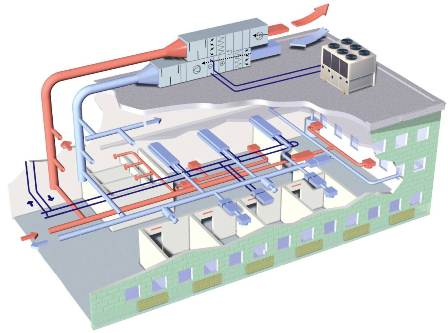What Is An HVAC System? – The initials HVAC stand for Heating, Ventilation and Air Conditioning. They describe the functions of an HVAC system. This mechanical system’s design is primarily an attempt to take control of the environmental conditions inside the space you work.
A HVAC framework is intended to control nature in which it works.
It accomplishes this by controlling the temperature of a room through warming and cooling. It likewise controls the dampness level in that condition by controlling the development and appropriation of air inside the room.
The framework likewise guarantees tidiness of air inside the said condition.
Kinds of HVAC Systems Available
The three fundamental kinds of HVAC frameworks accessible today are:
- Split and Window AC
- Bundled Heating and Air Conditioning System
- Focal AC System
How Does the System Work?
Not a wide range of HVAC frameworks work a similar way. Some are speedier than others while others serve bigger conditions. So, some HVAC frameworks are more viable than others in specific circumstances.
Here's the manner by which the distinctive frameworks work :
Split and Window AC Systems
In a window AC, fans blow air through the loops. This enhances how they isolate the warmth and icy. Warmth gets lost to the outside air while bringing cool is into the room.
Split ACs are utilized as a part of bigger application zones than window ACs. The split AC centers around part the cool from the hot side of the framework. The icy side has the cool loop and the extension valve. This is generally put inside a heater or some other type of air handler. The handler blows air over the curl and the cooled air is circulated to different rooms in the working through the air pipes.
Bundled Heating and Air Conditioning System
These units give an across the board advantage in that they have both warming and cooling gear in a solitary "bundle". Clients can put them in mechanical rooms, on the housetop or at a review near the molding space.
Not at all like in split frameworks where the cool and hot units are isolated, the bundle AC has every one of the parts in a single unit. These components have an outward fan or blower that disperses the air all through the components of the structure.
Focal AC Systems
The majority of the aeration and cooling systems in private structures are as part frameworks – just greater. They have a cooling fan, a condenser curl and a compressor housed in a different gathering unit. The evaporator loop is as a rule inside an air handler (indoor) unit ordinarily introduced on the heater. At the point when the heater is electric, a blower is incorporated into the framework.
The compressor utilizes power as its wellspring of energy to direct the refrigerant over the framework gathering indoor warmth and expelling it from the home. The warmth disseminates outside by the curl in the gathering unit.
Warm air inside gets blown through the indoor curl (chilly) to expel dampness and warmth. The warmth noticeable all around exchanges to the curl and along these lines the air cools. The water vapor gathers on the curl (since it is cool) and gathers inside a deplete dish. It goes outside through the condensate deplete.
The warmth, in the wake of streaming to the evaporator curl, pumps outside while the now cooled air inside the room courses through the fan reporting in real time handler. Subsequently, the indoor temperature is kept up.
The amount Energy Does the System Use?
There are a few deciding components to the amount of vitality that a framework employments. They include:
- The productivity of its segments
- How proper its size is in connection to your home
- Your nearby atmosphere
- The amount you utilize it
- The sort of fuel it employments
While assessing the framework's normal utilization of vitality, you have to take after industry-standard rating frameworks. Some of them are:
The SEER (Seasonal Energy Efficiency Ratio)
This measures a warmth pump framework or aeration and cooling system's cooling effectiveness. The higher the SEER the more prominent the productivity and the vitality sparing limit; Federal law requires new cooling frameworks to have a base rating of 13 SEER.
The AFUE (Annual Fuel Utilization Efficiency)
This rates oil or gas heaters to demonstrate the measure of fuel utilized as a part of warming your home and the squandered sum. The rating is in rates and the higher the AFUE rating, the more vitality proficient the framework is. It is a necessity by law United States-made heaters ought to have at least 80% AFUE.
The HSPF (Heating Seasonal Performance Factor)
This one quantifies the level of effectiveness of a warmth pump's warming mode. A high appraising means more noteworthy proficiency and reserve funds on cost. The law requires new warmth pumps to have no less than a 7.7 HSPF.
The Wattage
Wattage rates the measure of power your ventilation, aerating and cooling and warming framework uses to give an agreeable domain to you and your family. The unit of estimation is kilowatt-hours. Speed is the primary determinant of the wattage of your framework.
It is imperative to consider the effectiveness and vitality use of a framework before choosing to get it. These two components will go far in helping you decide the money-saving advantage proportion and whether it's justified, despite all the trouble.
